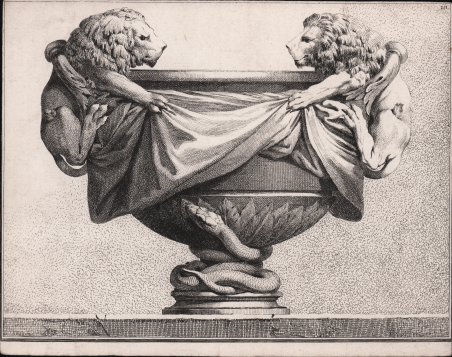Acquaforte, 1764, priva di data e firma. Della serie Suite de vases tirée du cabinet de Monsieur du Tillot marquis de Felino, da soggetti di E. A. Petitot. ' Realizzata nel 1764, questa raccolta di 30 tavole incise all’acquaforte da Benigno Bossi e basate sui disegni di Petitot, presenta vasi di pura invenzione ornamentale. Tre di questi sono stati realizzati e collocati nei Giardini di Parma. Nel lavoro dell’artista su questi vasi nello stile neo-classico le forme diventano astratte e puramente estetiche. In un mix di motivi ispirati all’antichità: pigne, scanalature, foglie di acanto, ghirlande, fregi, teste di leone, Petitot dimentica la funzionalità dell’oggetto «vaso» reinventandolo. Petitot elabora il gusto dell’antico creando una nuova grammatica visiva che mescola soggetti umani, animali, ghirlande, elementi architettonici classici per questa collezione di vasi straordinari. Un risultato armonico che mescola fantasia, architettura e regole Vitruviane. Bossi fu un esperto in tutti i procedimenti dell'incisione, da quelli lineari a quelli di tono - L'acquatinta (lavis) fu da lui portata al massimo delle sue possibilità di rendimento, sia come mezzo in sé sia in associazione con altri. Molta parte della sua attività di incisore fu dedicata alle opere del Parmigianino, per cui nutrì un vero culto. Del Petitot incise, oltre alla ' Suite de vases tirée du cabinet de Monsieur du Tillot marquis de Felino., ' Milano 1764, alcuni ' Caminetti ' di ispirazione piranesiana e una ' Mascarade à la Grecque d'après les dessins originaux tirés du cabinet de. le marquis de Felino., ' Parma 1771. Non contento di fare, come incisore, solo opera di riproduzione, intagliò fin dai primordi anche rami di sua invenzione, e su di essi anzi si compiacque di porre l'accento, quasi a rivendicare la sua genialità creativa, riunendoli più e più volte, con varianti, in volumi dai titoli diversi: Raccolta di teste inventate, disegnate ed incise da Benigno Bossi; ' Fisionomie possibili; ' Prove all'Acquaforte; ' Miscellanea; ' Trofei, ' ecc. La produzione delle "teste" e delle "fisionomie possibili" corrispondeva a una moda del tempo, che affondava le radici nelle famose deformazioni di Leonardo, ma che nel campo specifico dell'incisione era stata sfruttata specialmente dal Grechetto nel Seicento e dai Tiepolo nel Settecento: gli autori cioè che il Bossi sembra tenere specialmente presenti. Alle teste di maniera, quali di prevalenza venivano prodotte in quegli anni, egli volle evidentemente contrapporre le sue teste dal vero, notevoli per la loro icasticità e puntualizzazione espressiva. Bibliografia cfr. M. CASTELLI ZANZUCCHI, Contributo allo studio di Benigno Bossi, "Parma per l'arte", 1960, 10, pp. 149-185. Etching, 1764, without date and signature From the Suite de vases tirée du cabinet de Monsieur du Tillot marquis de Felino, after E. A. Petitot. Made in 1764, this collection of 30 plates etched by Benigno Bossi and based on Petitot's drawings features vases of pure ornamental invention. Three of these were made and placed in the Gardens of Parma. In the artist's work on these vases in the neo-classical style, the forms become abstract and purely aesthetic. In a mix of motifs inspired by antiquity: pine cones, grooves, acanthus leaves, garlands, friezes, lion heads, Petitot forgets the functionality of the "vase" object by reinventing it. Petitot elaborates the taste of the antique by creating a new visual grammar that mixes human subjects, animals, garlands, and classical architectural elements for this collection of extraordinary vases. A harmonious result that mixes fantasy, architecture and Vitruvian rules. Bossi was an expert in all processes of engraving, from linear to tone - Aquatint (lavis) was taken by him to its fullest performance potential, both as a medium in itself and in association with others. Much of his activity as an engraver was devoted to the works of Parmigianino, for whom he nurtured a true cult. Of Petitot he engraved, in addition to the Suite de vases tirée du cabinet de Monsieur du Tillot marquis de Felino., Milan 1764, some Piranesi-inspired Fireplaces and a Mascarade à la Grecque d'après les dessins originaux tirés du cabinet de. le marquis de Felino., Parma 1771. Not content to do, as an engraver, only work of reproduction, he carved from the very beginning also plates of his own invention, and on them indeed he was pleased to place the emphasis, as if to vindicate his creative genius, bringing them together again and again, with variants, in volumes with different titles: Raccolta di teste inventate, disegnate ed incise da Benigno Bossi; Fisionomie possibili; Prove all'Acquaforte; Miscellanea; Trofei, etc. The production of "heads" and "possible physiognomies" corresponded to a fashion of the time, rooted in Leonardo's famous deformations, but which in the specific field of engraving had been exploited especially by Grechetto in the seventeenth century and by Tiepolo in the eighteenth century: that is, the authors Bossi seems to keep especially in mind. To the mannered heads, such as of prevalence were being produced in those years, he evidently wanted to contrast his heads from life, remarkable for their icasticity and expressive punctuation. Bibliografia cfr. M. CASTELLI ZANZUCCHI, Contributo allo studio di Benigno Bossi, "Parma per l'arte", 1960, 10, pp. 149-185. Cfr.

Find out how to use
Find out how to use

